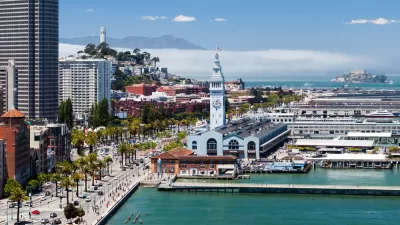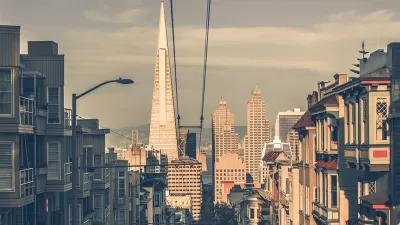New research documents how the weight of buildings causes the ground to sink underneath developments in the San Francisco Bay Area.

Kurtis Alexander reports: "The entire Bay Area is plunging downward under the weight of its own sprawl. And that’s a concern as sea levels rise and cities try to figure out how they’ll stay above water in the coming decades."
New research by Tom Parsons, a geophysicist with the U.S. Geological Survey, has shed light on the subsidence caused by development in the San Francisco Bay Area. Parsons published findings in a recent issue of the journal AGU Advances.
The most famous example of subsidence in San Francisco is Millennium Tower. The tony but beleaguered residential tower has sunk 16 inches in the decade since its construction and is tilting to the side. Although this one example is infamous, the issue hasn't been studied extensively in the aggregate, according to Alexander.
The study is likely to have implications in other cities, according to Alexander, especially when considering the collision course of sinking coastal cities with rising coastlines. "Other areas seeing significant development are also likely to have sinking buildings while similarly having to contend with sea level rise, the paper says." The Bay Area is further complicated by seismic activity, which can raise ground levels, pushing up against the weight of buildings and mitigating some of the subsidence effect.
FULL STORY: Buildings like S.F.'s Millennium Tower are causing the Bay Area to sink under their weight

Maui's Vacation Rental Debate Turns Ugly
Verbal attacks, misinformation campaigns and fistfights plague a high-stakes debate to convert thousands of vacation rentals into long-term housing.

Planetizen Federal Action Tracker
A weekly monitor of how Trump’s orders and actions are impacting planners and planning in America.

In Urban Planning, AI Prompting Could be the New Design Thinking
Creativity has long been key to great urban design. What if we see AI as our new creative partner?

King County Supportive Housing Program Offers Hope for Unhoused Residents
The county is taking a ‘Housing First’ approach that prioritizes getting people into housing, then offering wraparound supportive services.

Researchers Use AI to Get Clearer Picture of US Housing
Analysts are using artificial intelligence to supercharge their research by allowing them to comb through data faster. Though these AI tools can be error prone, they save time and housing researchers are optimistic about the future.

Making Shared Micromobility More Inclusive
Cities and shared mobility system operators can do more to include people with disabilities in planning and operations, per a new report.
Urban Design for Planners 1: Software Tools
This six-course series explores essential urban design concepts using open source software and equips planners with the tools they need to participate fully in the urban design process.
Planning for Universal Design
Learn the tools for implementing Universal Design in planning regulations.
planning NEXT
Appalachian Highlands Housing Partners
Mpact (founded as Rail~Volution)
City of Camden Redevelopment Agency
City of Astoria
City of Portland
City of Laramie




























